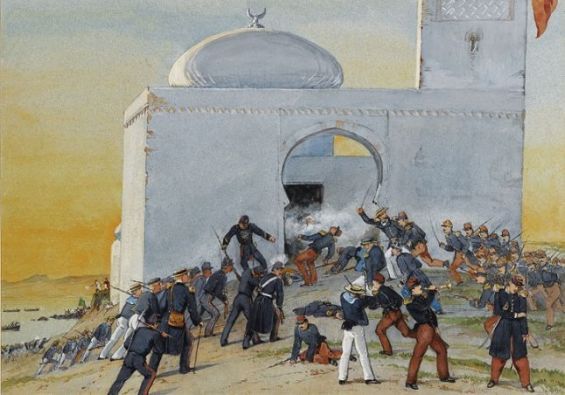The Tangiers treaty was a turning point in Morocco and Algeria’s history. The two neighboring nations were at the heart of the peace agreement signed on September the 10th, 1844.
The treaty was initiated to end the first Franco-Moroccan war and expel the Algerian religious leader Emir Abdelkader ibn Muhieddine, who found refuge in northeastern Morocco after the French colonial invasion in Algeria.
Emir Abdelkader's attempts
But before the Tangiers peace treaty was signed, Morocco and France had to fight a brief war. In her book «The French in Africa» (C.J. Skeet, 1859), Laurence Trent Cave wrote that the war started because of the Algerian Emir who, after losing «his fortresses and warlike stores… was reduced to little more than a chief of a roving band on the borders on the Desert».
 Algerian Emir Abdelkader./Ph. DR
Algerian Emir Abdelkader./Ph. DR
The Algerian left for the Kingdom, «preaching the Holy War with a view to gaining adherents among the lawless border tribes» in Morocco. Fortunately, Emir Abdelkader managed to secure the sympathy of Moulay Abderrahman, recalled the historian, stressing that «therefore, the violations of the Algerine territory became at once a question between France and Morocco».
Indeed, the French was firm with the Kingdom, threatening to «punish those who provoked its violations», and urging the sultan to withdraw protection from Abdelkader. The French believed that that latter «might, by the force of his religious influence, become at any moment the commander of the Moorish army», pointed the same source.
The bombarding Tangier and Mogador
France’s fears have pushed it to act by the end of July, 1844. Under the command of the Prince of Joinville, a French squadron headed to Morocco, leading to the bombardment of Tangier on the 6th of August.
The French troops invaded the northern city, rejecting the way in which Emir Abdekader was treated. After bombarding Tangier, the squadron sailed for Cadiz to heal the injured and repair what has been destroyed.
«Mr. Drummond Hay, the British Consul, had in the meantime hurried to the city of Moroccans, with a view to terminate the dispute; an on his return … Tangiers was undergoing the horrors of a bombardment», wrote Laurence Trent Cave.
 The bombardment of Tangier on the 6th of August 1844./Ph. DR
The bombardment of Tangier on the 6th of August 1844./Ph. DR
Tangiers was not the only city the French were targeting as after the Prince repaired damages in Cadiz, he ordered his troops to sail for Mogador. The Moroccan seaport was also bombarded on August the 15th.
«A landing was effected on the island (Mogador) and the batteries were carried; an obstinate hand to hand conflict then ensured and about four hundred Moorish troops kept up a severe fire against the French, sheltering themselves behind rock and walls».
The struggle lasted for more than an hour in Mogador, after the Moroccan troops retreated to a mosque and the city was in possession of the French. According to the account provided by the book «The French in Africa», eight French soldiers were «killed, including an officer, more than thirty were wounded, and a few casualties occurred on board of the ships from the fire of the Moorish batteries».
But once the city was controlled by the French the Prince ordered the dismantling of Mogador’s batteries. More than five hundred men entered the town and the Moorish flags were hauled down, while the fortifications were destroyed.
One day before raiding Mogador, the French fought the Isly battle. Searching for Emir Abdelkader, they faced the Moorish army which was considerably augmented after Moulay Abderrahman sent his son to command the troops near Oujda.
The Isly battle
On the 14th of August, the «French did not muster more than fifteen thousand men, but they at once took the initiative, and attacking the Moors, as they attempted to dispute the passage of the river Isly, threw them into confusion, capturing the umbrella, the personal equipage of the emperor’s son», recalled the historian.
Although the Moroccan army had large bodies of cavalry, the French resisted, and as soon as the Marshal assumed the offensive, the Moroccan side «fled in all directions».
 The Isly battle./Ph. DR
The Isly battle./Ph. DR
The French victory led to the signing of the peace treaty on the 10th of September. The latter forced the sultan to accept the French presence in Morocco, all while remaining neutral regarding the French invasion in Algeria. Through the treaty Morocco also recognized Algeria as part of the French empire.
The Tangiers Treaty considered Emir Abdelkader as an outlaw and ordered the Sultan to arrest him.





 chargement...
chargement...













